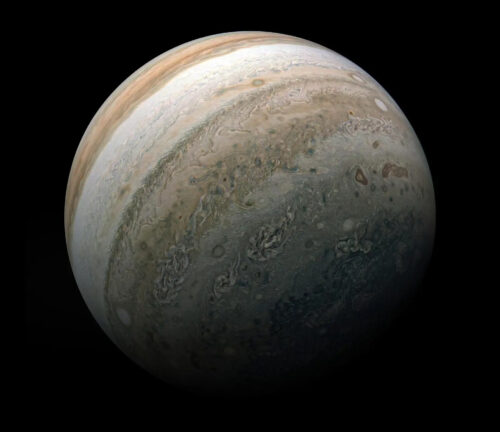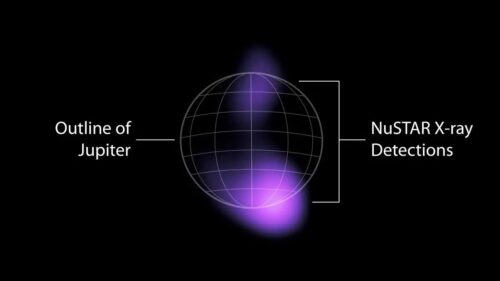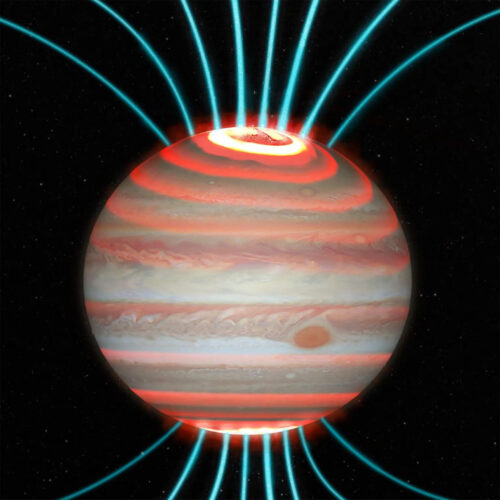
In a groundbreaking discovery, NASA’s NuSTAR (Nuclear Spectroscopic Telescope Array) mission has shed light on the enigmatic and dazzling light emanating from Jupiter. For years, scientists have been intrigued by the origin of this celestial phenomenon.
Now, thanks to the high-energy observations made by NuSTAR, the mystery surrounding Jupiter’s radiant glow has finally been unraveled. This remarkable breakthrough opens up new possibilities for understanding the complex interactions occurring within the largest planet of our solar system.
Jupiter, often referred to as the gas giant, is well-known for its awe-inspiring appearance, adorned with swirling clouds and vivid colors. Among its captivating features is its captivating light, which has long fascinated astronomers.
The source of this luminosity, known as Jupiter’s auroras, has perplexed scientists for decades. While auroras on Earth are produced by interactions between the planet’s magnetic field and solar particles, Jupiter’s auroras are different. The immense size and unique magnetic environment of Jupiter present an intriguing puzzle for researchers.
Enter NASA’s NuSTAR, an orbiting telescope designed specifically to detect high-energy X-rays. Launched in 2012, NuSTAR has been instrumental in unraveling the secrets of the universe. Recently, scientists turned their attention to Jupiter, utilizing the telescope’s unprecedented capabilities to investigate the planet’s enigmatic light. The data collected by NuSTAR has provided crucial insights into the mechanisms responsible for Jupiter’s captivating auroras.

The groundbreaking study revealed that Jupiter’s auroras are primarily driven by particles accelerated to extreme energies. These particles, believed to originate from the gas giant’s moons Io and Europa, are accelerated by the planet’s powerful magnetic field. As they interact with Jupiter’s atmosphere, they emit high-energy X-rays, creating the dazzling light display that has intrigued astronomers for years.
Dr. Fiona Harrison, the principal investigator of NuSTAR at the California Institute of Technology, expressed her excitement about the findings, stating, “We have seen Jupiter producing X-ray auroras for the first time. This discovery was only possible thanks to the unique capabilities of NuSTAR.”
The discovery of high-energy X-rays emanating from Jupiter has significant implications for our understanding of not only the planet itself but also the broader field of planetary science. By unraveling the mystery of Jupiter’s radiant glow, scientists can gain valuable insights into the interactions between planetary magnetic fields and their surrounding environments.
Furthermore, these findings have the potential to shed light on similar phenomena occurring in other celestial bodies throughout the universe. By studying Jupiter’s auroras, scientists can refine their understanding of the mechanisms that drive auroral activity in other planets, both within our solar system and beyond.

NuSTAR’s detection of the highest-energy X-rays from Jupiter opens up new avenues for future research. Scientists are now eager to explore the detailed dynamics of these high-energy particles and understand the underlying processes that generate Jupiter’s mesmerizing light display. The data gathered by NuSTAR will undoubtedly inspire further investigations and fuel new discoveries in the realm of planetary science.
With the puzzle of Jupiter’s astonishing light finally solved, the scientific community is poised to delve deeper into the mysteries of our solar system and beyond. The remarkable capabilities of NASA’s NuSTAR mission have once again demonstrated the power of cutting-edge technology in unraveling the secrets of the universe. As we continue to explore and understand the wonders of space, the radiant glow of Jupiter will forever serve as a testament to the incredible beauty and complexity of our cosmic neighborhood.
